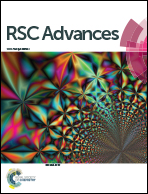Controllable drug release system based on phase change molecules as gatekeepers for bimodal tumor therapy with enhanced efficacy†
Abstract
A mixture of anticancer drug doxorubicin hydrochloride (DOX) and 1-tetradecanol (TD) are co-loaded into core–shell structured Cu9S5@mSiO2 nanoparticles to achieve bimodal tumor therapy with enhanced efficacy. TD, a kind of phase change molecule with a melting temperature (Tm) of 39 °C, acts as a gatekeeper to control DOX release. Cu9S5 is a kind of good photothermal agent and has the advantage of a high photothermal conversion efficiency, which has a thermal effect on TD. Cu9S5 NCs at a concentration of 312.5 ppm can elevate its temperature by 28.6 °C in 5 min when the system is irradiated by a 980 nm laser (0.5 W cm−2). When the temperature of the system is higher than 39 °C, TD can melt and DOX will release from the pores. Besides NIR-triggered release, the DOX release is also controlled by pH. Synergistic NIR-triggered and pH-triggered DOX release prevents the premature release of drug molecules (<4% of the whole loaded DOX in 24 h) in neutral conditions without irradiation. However, upon irradiation in acidic conditions (pH = 5.0), the release of the whole loaded DOX could reach 32.6%. Therefore, this versatile combination of photothermal therapy and chemotherapy makes the application of multifunctional drug delivery systems possible.


 Please wait while we load your content...
Please wait while we load your content...